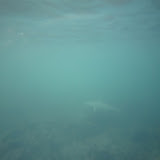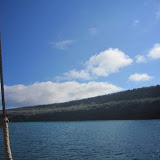I once again find myself writing an entry from an airplane, this time between Galapagos and Guayaquil, where I'll catch my final flight home to New York. Before moving on, though, I thought I'd write a bit about my last three days aboard the Angelique. In particular, I want to discuss our trip to Genovesa, the island that, among those I had not yet seen with the Cachalote, I most wanted to visit.
Genovesa is most noteworthy for its enormous population of nesting Great Frigatebirds. I've mentioned the frigatebird a bit already, and I knew that I found them fascinating, but getting to observe them up close crystalized my feelings. Let's get this out there now: frigatebirds are assholes. They are the assholes of the bird world. Seriously, total jerks. Frigatebirds*, also known as Man-O-War birds**, are most well known for their piratical habits. They steal everything they get. I've already mentioned that they often get food by harrassing other birds into disgorging a fresh catch, and swooping down to snatch it before it hits the water. It turns out they do this with nesting material as well, as I've now seen firsthand.
On Genovesa, we witnessed scores of Red-footed Boobies--the tree-dwelling and alternate-colored cousin of the Blue-footed and Nazca varieties--cutting small twigs from bushes with their beaks, and attempting to fly them back to their loved ones. You'd think birds would leave them alone. After all, they're just trying to build a good home for their kids. Well, most of the time, not a moment after the booby took flight, a frigatebird would swoop in from above and start pecking at and colliding with the booby. Occasionally, the booby would escape with the twig still in its mouth, and make it home--or at least out of my line of sight. For the most part, however, the incredibly dickish behavior of the frigatebird would cause the booby to freak out and drop its twig. As impressive as it may have been to then watch the frigatebird swoop down faster than the twig***, great feats of athleticism don't make up for shoddy morals. This ain't the NFL.
As I watched these acrobatic thugs do what comes naturally, I struggled to find the appropriate analogy. I initially thought it a bit like a neighborhood with a heavy mob presence. The frigatebirds take a taste of all the food and all the construction materials. The problem with that analogy is it would have to be a combined mob neighborhood / police state, because if you really lived in such a neighborhood, you would always have the option to leave it, and you almost certainly would.
I think, at the end, it's most like a normal American high school. I say "normal" because this kind of thing didn't really go on at the artsfest I attended during my formative years, but that's beside the point. The frigatebirds are the bullies and the red-footed boobies are the A/V club. Or the sci-fi club. Or the D&D club. Or Mathletes, perhaps. Take your pick. The only difference is that, in PS Genovesa, there are about twice as many bullies as there are nerds. The nerds wish more than anything that they could escape to a place without bullies, but they have nowhere else to go really. This is where the fish are, so that's where the nerds stay. So, the nerds have no real choice but to tolerate the frigatebirds' stealing their lunch money and their twigs. The boobies occasionally yell a bit in exasperation, and even throw the odd weak-looking peck. But they never really manage to retaliate in any meaningful way.
The courtship traditions of the frigatebird are also noteworthy. The male frigatebird has a big red throat-pouch that he can inflate to impress the females. If I may continue the game of "Torture That Analogy," (a favorite pastime of my brother Art and I), it is the bird equivalent of the bully--clearly already overcompensating for something--stuffing a sock in his pants. Often, on Genovesa, one will come across a large group of male frigatebirds sitting on the ground with their pouches fully inflated, waiting for a female (who has a very visible white patch of feathers in lieu of the pouch) to fly overhead. Whenever this happens, the males spread their wings and shake them, proudly displaying the size and redness of the pouch. In order to ensure the female's attention--just in case she might confuse the group for little Jimmy's fourth birthday celebration--they ullulate. Eventually, the female will choose the "ballon rouge" that suits her fancy the most, and settle down with a male. She will then blissfully pretend, a la Carmela Soprano, that the twigs and aluminum siding he brings her have come from an honest day's work****.
At any rate, Genovesa, isolated in the northeastern part of the archipelago and located fully north of the Equator, is unique because it is the only island that has neither introduced species nor land reptiles (of Galapagos's two iguana species, only the marine variety has made it as far as Genovesa). As a result, it is so full of birds as to be an appropriate setting for a remake of the Hitchcock movie. In addition to the frigatebirds and all three kinds of boobies (though Blue-footed are not very common there, and nest on other islands), it has a wealth of Red-billed Tropicbirds and a freakish amount of petrels.
The petrels pass their time trying to impress each other with aerial acrobatics along the cliffside, sweeping and swooping all over the place. The boobies and frigatebirds, by contrast, mostly just sit there and try to mate, giving off a range of freakish noises. As on the other islands, one can walk right up to the larger nesting birds. In addition to large amounts of puffed-up frigatebirds, we got to witness a Nazca Booby***** couple preparing to mate. The nesting ritual of the Nazca Booby is so endearing it makes me want to adopt a pair of them. First, as do all species of booby, they do a little dance with each other. Next, however, the male starts to help the female build a nest. Rather than fly off and find some good material for a foundation, like the other birds in the area, he just looks in his immediate vicinity. Upon finding a twig or a small pebble, the male will pick it up in his beek, and very gently place it at the foot of his mate. He will proudly repeat this process at least a few times, each time newly giving his bride the precious gift of a thing he just found.
As with any small cruise in Galapagos, we spent our fair share of time in the water as well. This time, however, the sights on land outshone the experience underwater, though there were certainly some good things to see below the surface. The water was very murky in Genovesa--less so in Bartolomé, which I had visited with the Cachalote and to which I returned with the Angelique. However, I did manage to see three major animals I had not previously seen, as well as a few new fish. In Playa Las Bachas, on the northern part of Santa Cruz, I saw a juvenile Galapagos Shark. Fully grown, these are slightly bigger than the white-tipped sharks, and more menacing-looking as well. In the obscure waters of Las Bachas, it appeared as a silvery flash in front of me, and then swam past without paying much attention. At Genovesa, we briefly saw an iguana in the water, feeding on some seaweed. I had seen this from land, but this was my first time in the water with one. Unfortunately, right as I got out my camera to take a picture, an enormous wave knocked us back about fifteen feet, and I missed my chance.
A short while later, we came across a fur seal, which is a relative of the sea lion, of course, but which behaves differently. Fur seals are nocturnal, so when they get into the water during the day, it's usually just to relax a bit. Their standard approach, which we witnessed, is to lie upside-down at the surface, all four flippers facing the sun, and head facing down. It's not as curious or playful as its Californian cousin, but it's still a lot of fun to watch.
Yesterday, in Bartolomé, I hoped to get another opportunity to swim with a penguin, and capture the photo that I missed last time. Although we saw a few of them sunning themselves as we swam by, our group apparently missed the only one that had been swimming by about five minutes, so it seems it was not in the cards. Fortunately, there's an important lesson to be taken from this. The thousands of pictures I've taken in the last four months serve as a wonderful record of all the excitement of this trip. They are, however, just that--a record. They are not, themselves, the point of the trip. As much as I might feel like kicking myself for not checking my camera before the first time I got in the water at Bartolomé, I am so lucky to have had the unique experience of swimming with a penguin in the first place, to say nothing of everything else I've had the opportunity to do in the last four months. The lesson is an obvious one, of course, but it was nonetheless good to be reminded of it before heading out with only the memories in my head and the pictures on my computer.
So, all told, I had an excellent final few days in Galapagos. Of the nine islands I visited in the archipelago, it would be very difficult to pick a favorite. Genovesa, however, would be in the top three, along with Española and Fernandina. Anyway, I started writing this post this morning on the flight from the islands to the mainland, and I'm now finishing it in the air over South America, only five and a half hours from JFK. This is not yet my last post, but that will happen soon enough. I'll stop getting to self-importantly broadcast my opinions and I'll rejoin my friends and family in the rest of the world. Not yet, but soon.
Saludos,
Seth
*The name, as I learned from Sid Meier in my youth, comes from the best boat a civilization can have before it discovers steelwork.
**Ibid, but switch in "colony" for "civilization" and "wins independence" for "discovers steelwork."
***Something high school physics class taught us would be impossible without air resistance.
****This part just works better with the mob analogy than the high school one. Apologies for any confusion.
*****I suppose I should address, at long last, the fact that this species is called the "booby." I'll just say two things about that: 1) The name comes from "bobo," which is a Spanish term for "clown," so given because of their mating dance, in which they show off their oversized feet. 2) Heh.
Fotografía:
 |
| Galapagos - Santa Cruz - Playa Las Bachas |
 |
| Galapagos - Genovesa - Prince Phillip's Steps |
 |
| Galapagos - Genovesa - Darwin Bay |
 |
| Galapagos - Santiago - Sullivan Bay |
 |
| Galapagos - Bartolomé - Pinnacle Rock |
 |
| Galapagos - Santa Cruz - Charles Darwin Station |












No comments:
Post a Comment
Note: Only a member of this blog may post a comment.